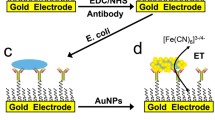Abstract
Objective
To effectively and conveniently detect pathogenic bacteria, this study aimed to develop label-free biosensors fabricated affinity peptides that can recognize targeted bacteria strains and enable precise quantitative detections.
Results
A 12-mer peptide with high binding affinity toward Escherichia coli O157:H7 was discovered by biopanning of phage-displayed peptide library. The peptide modified with glycine residues (G3) and one cysteine (C) residue at C-terminal, could self-assemble on gold electrodes, enabling electrochemical impedance spectroscopy (EIS) analysis for quantitative detection of E. coli O157:H7. This method showed a low detection limit of 20 CFU/mL and a liner range from 2 × 102 to 2 × 106 CFU/mL.
Conclusion
It appears that, by designing and optimizing the structures of peptides, such a strategy can be greatly promising in developing quick, sensitive and quantitative biosensor of pathogens.





Similar content being viewed by others
References
Bogomolova A, Komarova E, Reber K, Gerasimov T, Yavuz O, Bhatt S, Aldissi M (2009) Challenges of electrochemical impedance spectroscopy in protein biosensing. Anal Chem 81:3944–3949
Chowdhury AD, De A, Chaudhuri CR, Bandyopadhyay K, Sen P (2012) Label free polyaniline based impedimetric biosensor for detection of E. coli O157:H7 bacteria. Sens Actuators B 171–172:916–923
dos Santos MB, Agusil JP, Prieto-Simon B, Sporer C, Teixeira V, Samitier J (2013) Highly sensitive detection of pathogen Escherichia coli O157:H7 by electrochemical impedance spectroscopy. Biosens Bioelectron 45:174–180
Fang ZD, Laskey JG, Huang S, Bilyeu KD, Morris RO, Schmidt FJ, English JT (2006) Combinatorially selected defense peptides protect plant roots from pathogen infection. Proc Natl Acad Sci USA 103:18444–18449
Hwang HJ, Ryu MY, Park CY, Ahn J, Park HG, Choi C, Ha S-D, Park TJ, Park JP (2017) High sensitive and selective electrochemical biosensor: label-free detection of human norovirus using affinity peptide as molecular binder. Biosens Bioelectron 87:164–170
Katz BA (1997) Structural and mechanistic determinants of affinity and specificity and specificity of ligands discovered or engineered by phage display. Annu Rev Phys Chem 26:27–45
Kim YG, Lee CS, Chung WJ, Kim EM, Shin DS, Rhim JH, Lee YS, Kim BG, Chung J (2005) Screening of LPS-specific peptides from a phage display library using epoxy beads. Biochem Bioph Res Commun 329:312–317
Kulpakko J, Kopra K, Hänninen P (2015) Time-resolved fluorescence-based assay for rapid detection of Escherichia coli. Anal Biochem 470:1–6
Li Y, Afrasiabi R, Fathi F, Wang N, Xiang C, Love R, She Z, Kraatz HB (2014) Impedance based detection of pathogenic E. coli O157:H7 using a ferrocene-antimicrobial peptide modified biosensor. Biosens Bioelectron 58:193–199
Liu X, Marrakchi M, Xu D, Dong H, Andreescu S (2016) Biosensors based on modularly designed synthetic peptides for recognition, detection and live/dead differentiation of pathogenic bacteria. Biosens Bioelectron 80:9–16
Mannoor MS, Zhang S, Link AJ, McAlpine MC (2010) Electrical detection of pathogenic bacteria via immobilized antimicrobial peptides. Proc Natl Acad Sci USA 107:19207–19212
Rao SS, Mohan KV, Gao Y, Atreya CD (2013) Identification and evaluation of a novel peptide binding to the cell surface of Staphylococcus aureus. Microbiol Res 168:106–112
Ruan C, Yang L, Li Y (2002) Immunobiosensor chips for detection of Escherichia coli O157:H7 using electrochemical impedance spectroscopy. Anal Chem 74:4814–4820
Vaisocherova-Lisalova H, Visova I, Ermini ML, Springer T, Song XC, Mrazek J, Lamacova J, Lynn NS Jr, Sedivak P, Homola J (2016) Low-fouling surface plasmon resonance biosensor for multi-step detection of foodborne bacterial pathogens in complex food samples. Biosens Bioelectron 80:84–90
Zita A, Hermansson M (1997) Determination of bacterial cell surface hydrophobicity of single cells in cultures and in wastewater in situ. FEMS Microbiol Lett 52:299–306
Acknowledgements
This work was supported by the National Natural Science Foundation of China (Grant Nos.31471659, 21636003 and 21303050) and the Natural Science Foundation of Shanghai (Grant No.19ZR1412400).
Supporting information
Supplementary Table 1—Enrichment of positive phage clones by subtraction biopanning
Supplementary Table 2—The peptides isolated from the 3rd and 4th round.
Supplementary Fig. 1—Bode plot for impedance measurement of an APs modified electrode, varying concentration of E. coli O157:H7 from 2 × 10 to 2 × 106 CFU/mL. (Filled rectangle) 2 × 10 CFU/mL. (Filled red circle) 2 × 102 CFU/mL, (Filled blue triangle) 2 × 103 CFU/mL. (Filled green inverted triangle) 2 × 104 CFU/mL. (Purple left sided triangle) 2 × 105 CFU/mL. (Filled light green right sided triangle) 2 × 106 CFU/mL.
Author information
Authors and Affiliations
Corresponding author
Additional information
Publisher's Note
Springer Nature remains neutral with regard to jurisdictional claims in published maps and institutional affiliations.
Electronic supplementary material
Below is the link to the electronic supplementary material.
Rights and permissions
About this article
Cite this article
Shi, F., Gan, L., Wang, Y. et al. Impedimetric biosensor fabricated with affinity peptides for sensitive detection of Escherichia coli O157:H7. Biotechnol Lett 42, 825–832 (2020). https://doi.org/10.1007/s10529-020-02817-0
Received:
Accepted:
Published:
Issue Date:
DOI: https://doi.org/10.1007/s10529-020-02817-0




